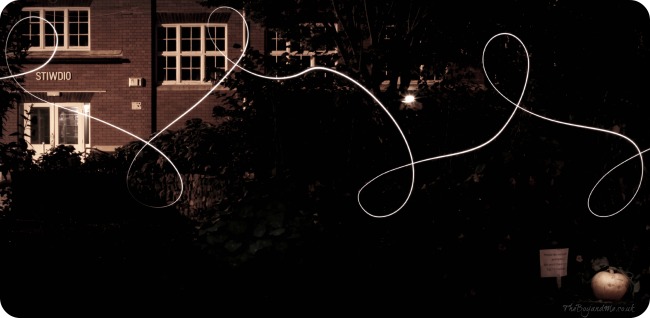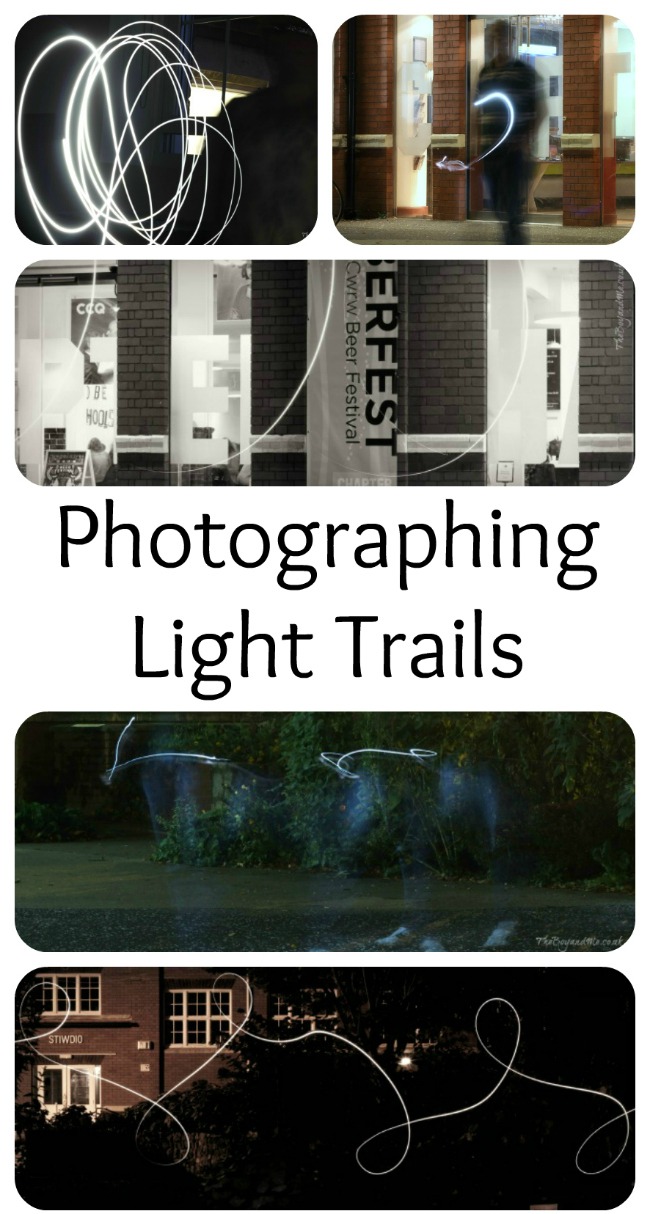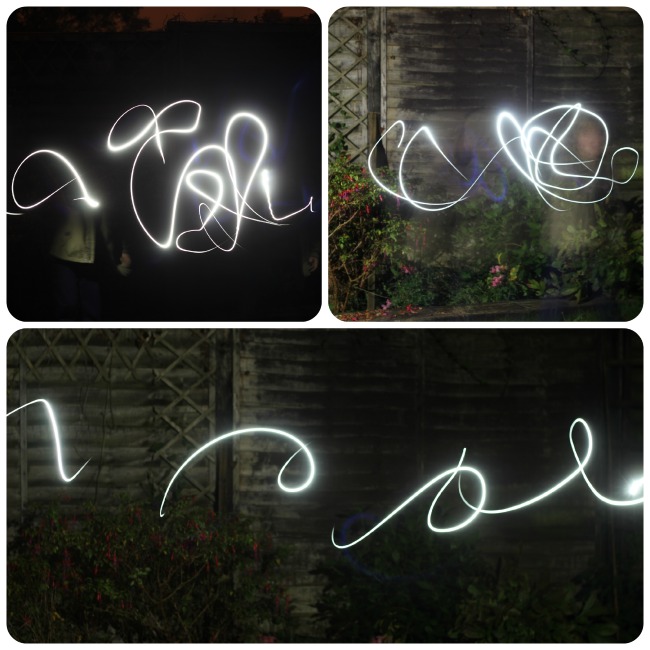
I was very lucky to have recently been invited to a night-time photography workshop in the magnificent Chapter Arts Centre in Cardiff. The session was run by a professional photographer who wanted to show us how to photograph light at night time, specifically light trails, on behalf of a travel company who specialise in holidays to see the Aurora Borealis.
Prior to this session I'd managed to photograph the moon successfully, but that's not hard once you've worked out the settings and have a tripod; the moon isn't known for moving terribly fast across the night sky. The real challenge is photographing moving light, and at this time of year with fireworks adorning the heavens, it's a technique that I was keen to master.
The tutor went through the difference between Shutter Priority and Aperture Priority, but I prefer to shoot on Manual as I like to balance the three different aspect of exposing a photograph myself. He also shared with us information regarding shutter speeds (measured in fractions of a second) and aperture, this is included below.
- Shutter Priority (TV): the photographer controls the shutter speed and ISO, but not the aperture, that is selected automatically by the camera. This is good for freezing or capturing motion.
- Aperture Priority (AV): the photographer selects the aperture (depth of field) and ISO. This is ideal for photographs where a great depth of field is required.
- Manual setting (M): the photographer controls ISO, shutter speed and aperture.
Shutter Speeds
- 1/4000 – 1/2000 will stop the wings of a hummingbird
- 1/1000 – 1/500 will freeze an athlete running
- 1/250 – 1/60 will stop everyday motion
- 1/30 – 1/8 will blur motion
- 0.5 – 30” will capture low light, motion and long exposures
Aperture
Aperture means the size of an opening. Photograph frames and picture mounts have apertures in them. In photography, aperture refers to, put simply, how big the hole in the lens is. If it is open wide, the more light can come in. If it is narrow, less light can travel into the lens and camera. It works the same way as pupils in an eyeball adjusting to different light conditions. Confusingly, the smaller the aperture/hole letting through less light then the larger the number (e.g. f22), whereas the larger the aperture (letting through more light) then the smaller the number (e.g. f2.8). Aperture can also be used to control depth of field, but this isn't something to be worried about with night-time photography.
ISO
ISO used to refer to film speed, and was used more with film cameras where the speed of the film needed to be set to allow the correct amount of light to be captured. I remember my dad years ago telling me that ISO 100 was for outdoor and sunny photography, 200 was for a grey day (a good all-round setting), and 400 was for indoor photography. This still stands true nowadays, although my dSLR can reach an ISO of 6400. I wouldn't use it very often though; it may allow more light to be captured in dark settings, but the photograph would have a lot of 'noise' or grain on it spoiling the photo.
As we were attempting to photograph light, and moving light specifically, we needed to focus on adjusting shutter speed to ensure we could capture the motion in the best way. Initially we photographed someone in a blackened room waving around their mobile phone with the flashlight app turned on. This illustrated well that because the shutter is open for longer, it freezes the trail that the light paints onto the 'film' (CCD = charge-coupled device, the special sensor which acts as the modern day film for digital cameras). And because we had the shutter open for longer, the size of the aperture needed to be small so that additional background light didn't drown out the trail.
Following this initial experiment, we went outside where we explored light trails (and I discovered about 'ghosting', i.e. motion blur), and also light painting.

ISO = 200, aperture = f/10, exposure = 15 seconds
I'd attempted photographing sparklers in the past with some degree of success, but had always worried about aspects like motion blur and trying to keep The Boy perfectly frozen and in focus. As a result of this workshop, I realised that actually motion blur can be very effective in a photograph of this style. This was something I was keen to explore with The Boy in the garden one evening recently, and I'm quite happy with the results.
These photos show this motion blur (ghosting), light trails (created with the flashlight feature of a mobile phone), and light painting. Light painting is created where one area of the dark scene is highlighted by a torch for a fraction of the time that the shutter is open. The image on the left below was without any light painting, the image on the right has my husband shining a torch where my son was dancing with his torch. It means that part of the background is exposed, but also there is a 'ghosted' image of him as he moves.

ISO = 200, aperture = f/3.5, exposure = 5 seconds
This is definitely something that I'm going to play with more during the dark evenings, especially to produce some creative photographs.
There are two really great types of photographs to illustrate moving light. One is capturing the headlights of fast cars at night, and the other is photographing sparklers.
Photographing Sparklers

ISO = 100, aperture = f/11, exposure = 20 seconds
If you want to have a go at writing with sparklers as I did, you'll need a tripod, multiple sparklers (because it takes a few attempts to get it right) and a sheet of black card. Oh and patience. I used the setting above with my camera mounted on a tripod and pointed in an area of black. My husband was standing by with a sheet of black card to put over the lens, while I lit the sparkler and stood in position. Because I'm moving quickly (and wearing black) then my arm doesn't show up. When I got to the end of the word, my husband put the black card over the lens while I put the sparkler in the right place for the next word; the black card blocks the light from being recorded for that time which creates a break in the sparkler trail.
The key thing when photographing on a long exposure is to use a tripod as the photographer cannot keep the camera still for that length of time.
There is a tutorial on Photographing Sparklers here, and more information about our photography workshop from Transun is here.
Are you going to try a little night photography this Winter?


i've played around with sparklers in previous years which is always fun but this year I found some glow sticks in the supermarket and I really want to give them a whirl – I just need it to stop raining every evening!
I wish I could do this, it looks amazing. x
awesome!
It looks fantastic! I don't think I'll be trying any of it over the winter though.
Just yesterday I was playing with light painting whilst glamping in a forest, I mean I had to have something to do to occupy me whilst I had no internet 🙂 I will show you my results soon
Loving your pictures
Love this! I can't wait for bonfire night and sparkler photos – great tutorial here! xxx
That is such an amazing sparkler shot! Lots of great tips!
I am now 🙂
Thank you
Briliant and really clear, not sure I can do it but a great explanation
Oooh. Okay, I NEED you to come out with me and show me all of these things. Quick, come and show me and help me
Last year I managed to get a great image of my daughter with a sparkler and her face was perfectly captured in the centre of the light trail. I was very pleased with that shot. Like you I want to experiment with light motion images a lot more… roll on the 5th November
Mollyxxx
It was a great workshop. I think you were probably able to take more from it than me, since you're more experienced. Love the blog title in sparkler effect.
I love the look of this, such a clever concept and what a stunning photo it makes x
that was a really interesting read and well written. Well done and thank you
Wow, incredibly clever and skilled work. Love the sparkler art work at the end (it really is a work of art – and I enjoyed reading how you and your husband worked together to achieve it).
What a brilliant tutorial, thank you! I am going to try and practice before we head to a firework display at the weekend.
Shame I missed this I would have love to have gone as I live just around the corner in Llandaff.
I think there is a talk coming up soon on how to mount your pictures and what materials to use etc if anyone is interested